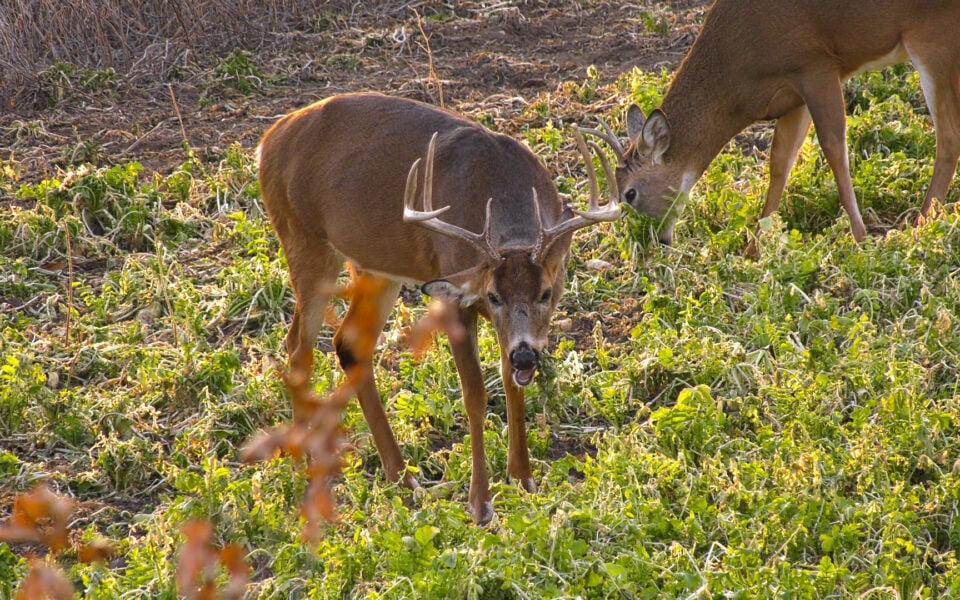From the time Toxey Haas and BioLogic first guided “whitetail deer management” into the age of planting brassicas for whitetail deer, we have been researching and learning more about them, and understanding better how to utilize different brassicas to help us accomplish a wide variety of management goals. If you have enough ground to devote to your food plot program, most managers would agree that a well-diversified feed program with an assortment of plants that will offer your herd what they need regardless of the time of the season or current conditions is the way to go. Some of the plants you choose would likely be perennials, but for the best in attraction during the hunting season it’s hard to beat a food plot full of luscious late summer to fall planted annuals.
What is a Brassica
The Brassicaceae family of plants is large and diverse and includes some of the world’s most important cultivated crops such as broccoli, turnip, cauliflower, and kale just to name a few. Most of the plants are in the genus, Brassica, but others such as radish are in a different genus. In the whitetail world, we collectively refer to all of them as “brassicas,” and many have proven to be an incredible food source for deer.

From its start over 20 years ago, Biologic has “hung its hat,” so to speak, on providing customers with the best forages available for whitetails. This push in the 1990s to find new and exciting varieties to grow for deer helped us introduce a family of plants that, at the time, were relatively unknown to most hunters to be anything a deer would eat. With hundreds of different plants in the Brassica family, and from the untrained eye, they all just look like the “greens” our grandparents would have grown in a fall garden. These new brassica plants were a completely new spin when it came to providing food for whitetails. The massive amount of forage they could grow in a short growing season was (and still is) incredible to most.
Why Plant Brassicas for Whitetail Deer

To start, there are so many different scenarios and variables when it comes to food plots and where they are planted – high or low deer densities, rich or poor native habitat, tons of Ag crops or total lack thereof in certain areas, pine plantations of the south to the great north woods. All this to say that very rarely are any two situations the same, and deer in some areas can afford to be picky because of an abundance of other food sources, and in others your plot may be the best source for miles around.
If you’re introducing a new plant to an area it may take you a while to battle a learning curve. The deer not hitting brassicas right away can happen, especially in the south, but in other areas they seem to have no hesitation on the new food source. We see some areas where the deer don’t become very interested in a brassica plot until winter hits and much of the natural forage has frost-killed or been consumed. This is a good thing because it gives the plant plenty of time for growth before heavy browse pressure occurs. Mother doe has taught her offspring to feed on various food sources throughout the year, and then her offspring teach their offspring, and so on…to feed on acorns this time of year, alfalfa this time of year, corn this time of year, etc. Once they learn what a brassica plant is, expect consumption to happen earlier and earlier each year. On many of the hunting properties we and our customers manage in the south, the deer have no hesitation eating Brassicas as early as September because they are acclimated to it as an excellent food source. Generally, the longer you plant them on a property, the more familiar several generations of deer get with the plants, and utilization seems to get earlier every year as your herd begins to imprint and recognize it as a highly preferred food source. This is where the science of putting different types of rape/kale hybrids, turnips, radish, etc. into ideal ratios really starts to shine as they all have different prime palatability dates and maturity rates.
The onset of colder weather triggers some changes in a whitetail’s metabolism, and thus need for different foods. When the weather is mild, deer seem to prefer clovers, cereal grains, etc., but as cold weather sets in their bodies tell them it’s time to utilize more carbohydrates, fat, and energy rich foods like acorns, brassicas, and standing beans. The wide varieties of different plants in the Brassica family we use at Biologic all have a purpose in their respective blends. Radishes seem to always be the most palatable early in the season, often times when there is still plenty of native vegetation available, and well before the cold weather occurs. Our turnip varieties are bred to be available and still palatable in the latest part of the winter, even with a deep covering of snow, and our hybrid rape and kale varieties all fall somewhere in between and are incredible for really the entire fall/winter.
How to Plant Brassicas for Deer (Seeding Rate)

One caution we give to gamekeepers is to be sure not to use too much seed when planting brassicas. Plants in this family have very small seeds and have broadcast rates as low as 5 to 10 pounds per acre. These very small seeds can grow a lot of tonnage in a growing season with correct rates, rainfall, and nutrients. However, when seeds in the Brassica family get spread too heavily for the given amount of soil/field size, competition for root space, moisture, and nutrients can quickly become too great resulting in a stunted field or crop die-off.
In our experience, it is best to use a hand spreader for these small seeds so you have good control on the amount you are putting out. Ideally you should spread it conservatively enough to cover the field in two different directions to ensure even seed distribution. ATV and pull behind spreaders can work so long as the gate opening can be fine-tuned for these tiny seeds. Another issue with seeding rates with bulb-producing brassica crops like turnips or radish is “bulb production” versus tops or “forage output.” Although the time of the year these are planted has a major impact on root vs top production, plants like turnips that are planted too heavily will usually produce a very small bulb in response to the overcrowding.
When to Plant Brassicas for Deer

When planting brassicas for deer, timing is important to maximize tonnage. Annuals, in general, are typically easy to plant, and since these are a “late summer – fall planting,” the summer weed cycle should be over, for the most part. While always called a “fall planting,” you’ll see that we call these “late summer – fall” or “cool season” plantings. Because if you’re waiting to plant some of these until it’s literally fall (September 22nd or 23rd depending on the year and your location), in some areas you may end up with a failure, or at the very least you’re not getting the most forage volume out of the plants, especially brassicas.
In the northern region and into Canada, brassicas should be planted from July through early August, and cereals planted from late July (in the far north around the Canadian border) through August or even September further south (IA, IL, NE, etc.). Obviously that should be adjusted a bit later the further south you go, all the way into October for the Deep South.
If you have never tried any BioLogic blends when planting brassicas for whitetail deer, we highly encourage you to test them for yourself and see what a game-changer they can be. The amount of tonnage they can grow and number of deer they can support is incredible, and we feel like it is one of the most superior plantings for whitetails. If you believe brassicas will be a totally new crop for your deer, we recommend using a blend of cereal grains and clover with the brassicas as a great way to introduce them. Final Forage, Maximum, Deer Radish and Winter Bulbs are our “all-brassica” blends that can be planted as a stand-alone crop, or added to large fields with cereal grains to help you provide the best fall and winter nutrition for your herd…regardless of where you live.









